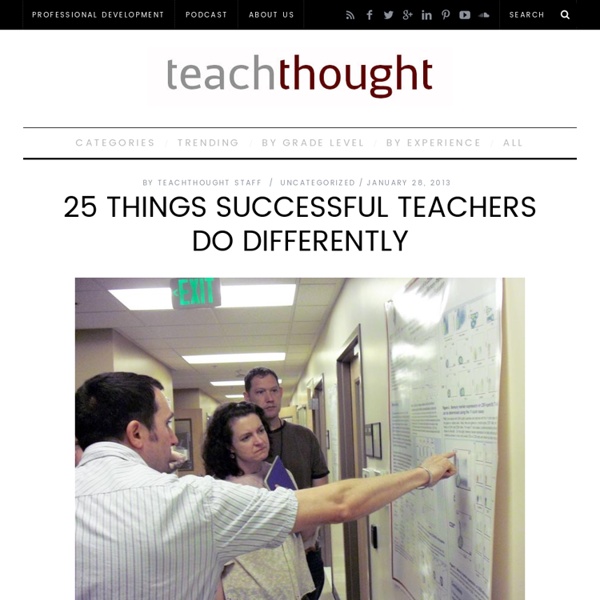10 Ways to Sabotage Your Classroom Management
By Jennifer Gonzalez You know the basics: Establish clear rules and consequences, be consistent, keep students engaged. But even with all that in place, the small things you do could be wreaking havoc on your whole system. Here are some habits you might have developed that are messing with your classroom management, along with more effective alternatives. 1.
The 3 R’s of Collaboration
One of the reasons I love Google Docs is that Google Docs easily creates a secure environment for collaboration to take place. Download your 3 R’s of collaboration poster. [Click to Share this poster on Twitter]
Five-Minute Film Festival: Virtual Field Trips
The dog days of summer are upon us; now is the time when all the other activities have run out. Whether you're a parent looking to entertain bored, overheated children, or a teacher already brainstorming ways to break down the four walls of your classroom in the fall, how about taking a virtual field trip? As edtech writer Audrey Watters argues, real-life field trips offer enriching experiences that virtual ones can't, but resources are not always available for in-person trips. Besides -- virtual trips can take you places that wouldn't be logistically possible in the real world.
No Student Is Unreachable
No Student Is Unreachable by Jeffrey Benson As an educational elder with a lot of experience working with challenging students, I am often asked to consult to school teams. Recently a dedicated school counselor discussed with me Garrett, an 8th graders, saying, “He’s really depressed, completely shut-down. He does no work.
5 Questions You Should Ask Your Principal
I was recently asked by a superintendent if I had some questions to ask his principals to start off the year. The questions I gave him were based on the following areas: Fostering Effective RelationshipsInstructional LeadershipEmbodying Visionary LeadershipDeveloping Leadership CapacityCreating Sustainable Change
Why You Should Let Students Have Unlimited Screentime
There’s a lot of debate about screentime for youth. Not only is it important for teachers to be familiar with the research, but Holly Flanders, CEO of Choice Parenting reminds us that parents, nannies, and any childcare provider must also be armed with accurate information. Flanders was recently quoted in the New York Post explaining why misinformation and misunderstanding can be a problem.
Educational Technology and Mobile Learning: The 33 Digital Skills Every 21st Century Teacher should Have
By EdTech Team Updated on march 2, 2015 : The original list that was created in 2011 comprised 33 skills , after reviewing it we decided to do some merging and finally ended up with the 20 skills below. The 21st century teacher should be able to : 1- Create and edit digital audio Here are some tools for teachers to develop this skill :Free Audio Tools for Teachers 2- Use Social bookmarking to share resources with and between learners Here are some tools for teachers to develop this skill : A List of Best Bookmarking Websites for Teachers 3- Use blogs and wikis to create online platforms for students Here are some tools for teachers to develop this skill : Great Tools to Create Protected Blogs and Webpages for your Class
Five-Minute Film Festival: Freedom to Fail Forward
Failure is an inevitable part of life, but it's often accompanied by shame -- most people do everything in their power to avoid it. But to paraphrase educational philosopher John Dewey, a true thinker learns as much from failures as from successes. What if educators worked to take some of the sting (and the stigma) out of failing, and encouraged reflection and revision to build upon the lessons learned? Perhaps there's a goldmine of opportunities if we can re-frame failure as a valuable learning experience, an essential step along the path to discovery and innovation.
Technology Integration, 1 to 1, and Student Centered Learning: Five Ideas to Consider
Welcome to this first in a series of posts devoted to student centered learning in the technology enhanced classroom. This classroom might be 1 to 1, or might be using technology to leverage student centered learning. I have five powerful ideas on facilitating student centered learning with technology in this post. The next posts will include 16 sweet tools that are a must for that student centered classroom.
11 Habits of an Effective Teacher
Carrie Lam , Academic Director, Teacher & Workshop Leader, Canada Posted 07/05/2014 10:12AM | Last Commented 08/12/2016 7:57AM I really appreciate teachers who are truly passionate about teaching.
Flipping with Fisher: Microsoft Office 365, Oh My!
I've been missing in action for a minute. This has been a busy year to say the least! Last year, without being a Google classroom, I used Google Docs, and Google Drive with my students.
Complete List of Movies About Schools and Teachers
WeAreTeachers is pulling together a running list of movies with schools as the plot and/or setting, and we'd love your help! We know there must be some good ones missing but we stopped at 101. The Ground Rules: 1) Only K–12. Not college. So films like Good Will Hunting and Daddy Day Care don't make the cut. 2) Documentaries are permissible. 3) Made-for-TV movies are allowed but not TV series. 4) Foreign films are allowed.



